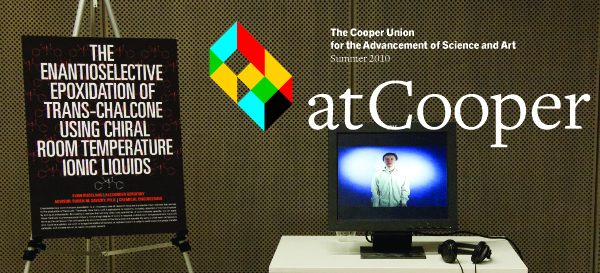Designer Thomas O’Brien (A’86): Man of the Moment
POSTED ON: June 1, 2010
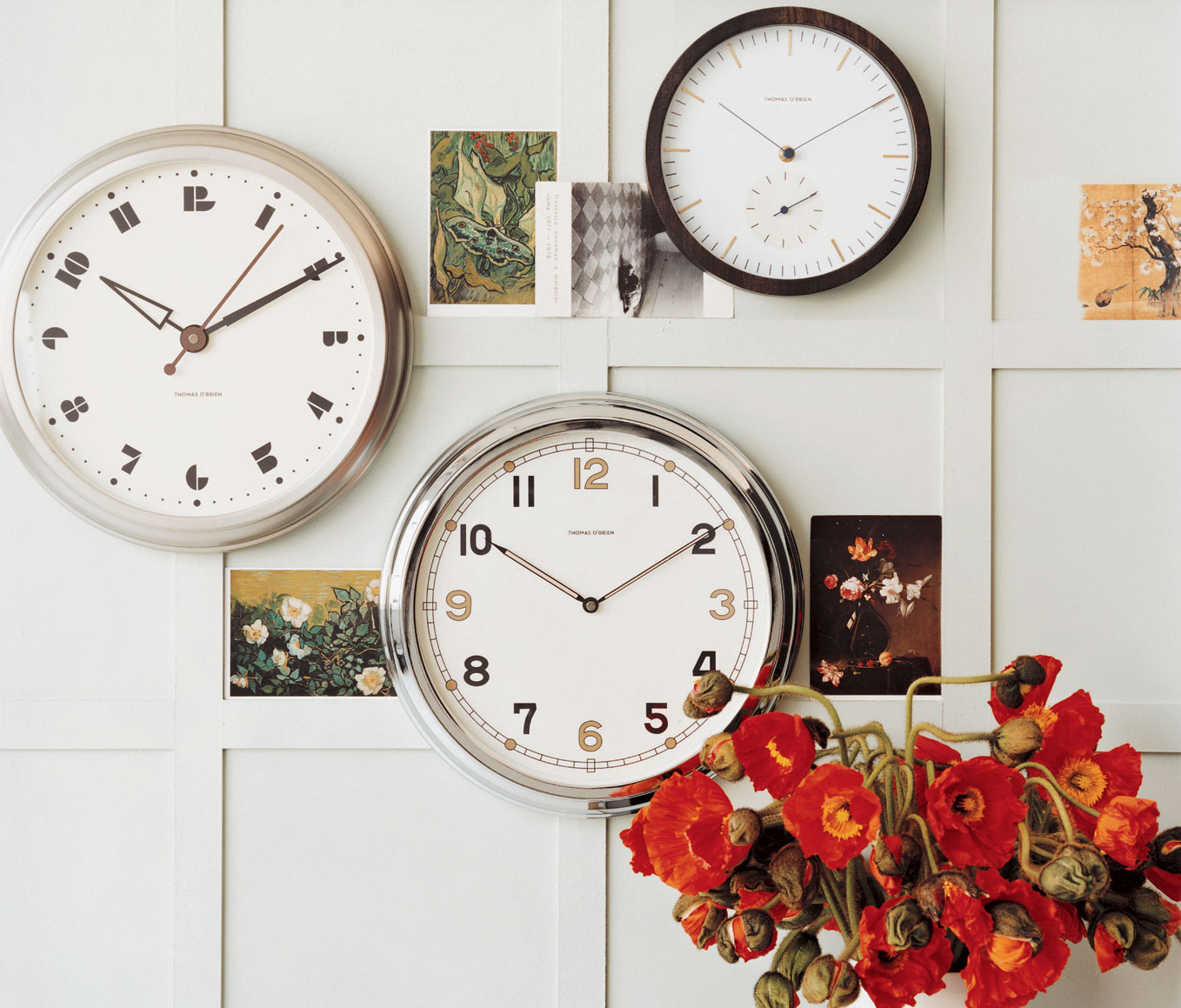
Above: Wall Clocks designed by Thomas O'Brien for Target
In the early 1980s, a 21-year-old self-proclaimed “skinny little kid” named Thomas O’Brien arrived in New York City. He came from the upstate New York town of Endicott via Franklin & Marshall College in Pennsylvania, where as a third-year pre-law student he was following in the footsteps of his father, uncles and brothers: after graduation, like them, he would go to work for IBM in his hometown. But, by chance,O’Brien took a printmaking class and was introduced to a professor who happened to be a Cooper Union alum.
Today, Thomas O’Brien (A’86) is widely recognized as a leading American interior designer, home furnishing designer and taste maker. His brand of “warm Modernism” is virtually everywhere—from the homes and retail stores of Ralph Lauren and Giorgio Armani to the shelves of Target and a handful of leading home furnishing manufacturers. In 2003 he was named Designer of the Year by Elle Decor. For the last decade, he has appeared annually on House Beautiful’s America’s Best 100 Designers list. Earlier this year, his long-anticipated first book, American Modern, was released by Abrams.
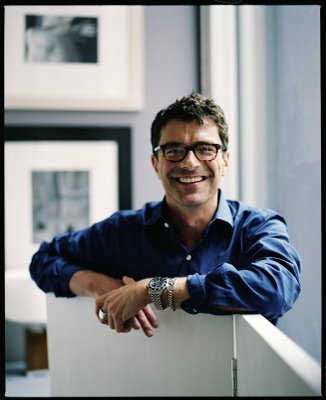 “Everybody said,‘What are you doing?’” he says with a laugh, recalling his decision to transfer to Cooper Union just a dozen credits shy of graduation. “But I was thrilled by the whole idea—for me it was about both coming to Cooper Union and coming to New York City.” Three decades later, O’Brien exhibits that same enthusiasm as he walks around Aero, his SoHo design studio and store that showcases a mix of his own designs and vintage items he’s collected over the years.He points to light fixtures designed for Visual Comfort, furniture for Hickory Chair, tableware for Reed & Barton, floor plans for the renovation of an apartment on Manhattan’s Upper West Side, and then to a new residence in Austin, TX. Molding profiles for a Pottery Barn store hang on a wall, new patterns for Target textiles and carpets for Safavieh sit on a shelf, and an 1820s Duncan Phyfe chair that O’Brien bought at auction is on display atop a table.
“Everybody said,‘What are you doing?’” he says with a laugh, recalling his decision to transfer to Cooper Union just a dozen credits shy of graduation. “But I was thrilled by the whole idea—for me it was about both coming to Cooper Union and coming to New York City.” Three decades later, O’Brien exhibits that same enthusiasm as he walks around Aero, his SoHo design studio and store that showcases a mix of his own designs and vintage items he’s collected over the years.He points to light fixtures designed for Visual Comfort, furniture for Hickory Chair, tableware for Reed & Barton, floor plans for the renovation of an apartment on Manhattan’s Upper West Side, and then to a new residence in Austin, TX. Molding profiles for a Pottery Barn store hang on a wall, new patterns for Target textiles and carpets for Safavieh sit on a shelf, and an 1820s Duncan Phyfe chair that O’Brien bought at auction is on display atop a table.
“The store is a mix of my designs and vintage items,” he says. “Sometimes some of the purely modern folks will be in here and say,‘Why is there a Victorian this or a Georgian that?’ But I’m interested in the design of all things, and along with that, in its own time, everything was contemporary and modern. So it’s all up for grabs in terms of what I like to interpret.” O’Brien’s designs,which encompass the entire spectrum of interior furnishings, convey both a traditional look and a modern sensibility—or vice-versa—creating something of a complex, composite aesthetic on vivid display in the Aero store: the juxtaposition of traditional forms and sleeker, more modern designs. It is in this open-minded approach—this mix of formality and informality, history and modernity—that O’Brien has found his milieu, making his work accessible to clients with both traditional and more contemporary tastes.
“Very often I find people will be attracted to something other than what they live with, but won’t let themselves try it,”O'Brien writes in the introduction to American Modern. “The traditional client is drawn to modern things; the person from a modern world craves antique things. For those who find their way to me, my products, or my store, the major breakthrough is always seeing that these elements can coexist, and actually look better together than apart… when people ask about what I do, I might say that I help find the classic elements from past generations, and then edit them together for this one. An American idea of reinvention: traditional things for modern living.”
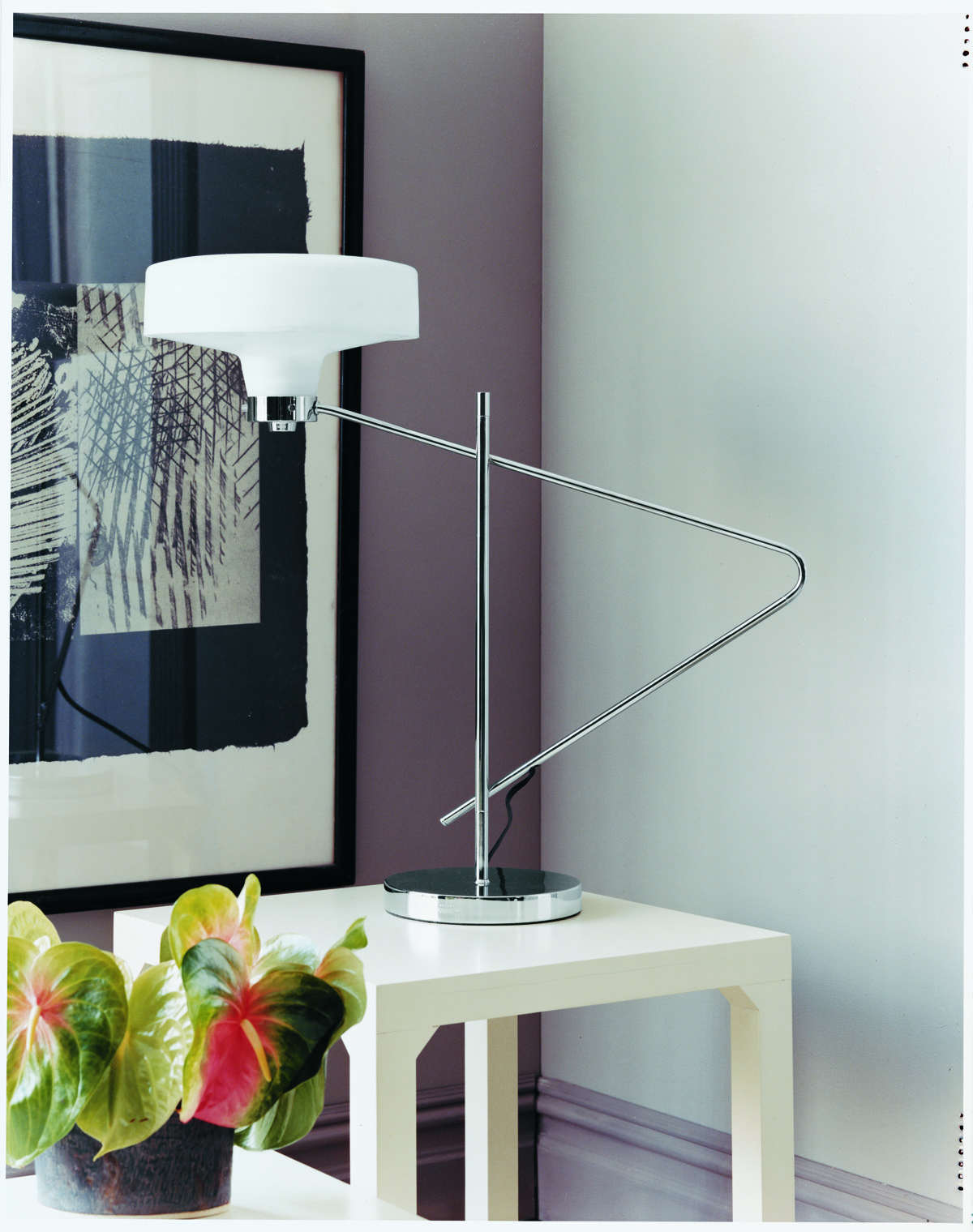 Mixing old and new means that O’Brien spends a lot of time carefully selecting vintage items, and he comes by his passion for collecting honestly. As a child, he would tag along with his father and grandparents when they went to estate auctions and antique shops.“When they would take apart a barn in a day-long auction, you would see generations of bedroom sets, dining room sets, etc.,” he says. “Sometimes those items would go back to the 1820s or earlier. And then there were a lot of antique stores all over rural upstate New York with really knowledgeable proprietors.”
Mixing old and new means that O’Brien spends a lot of time carefully selecting vintage items, and he comes by his passion for collecting honestly. As a child, he would tag along with his father and grandparents when they went to estate auctions and antique shops.“When they would take apart a barn in a day-long auction, you would see generations of bedroom sets, dining room sets, etc.,” he says. “Sometimes those items would go back to the 1820s or earlier. And then there were a lot of antique stores all over rural upstate New York with really knowledgeable proprietors.”
At Cooper Union, O’Brien focused on photography and sculpture. “Art school students tend to be cynical, but I was the one who loved it,” he says, noting that he particularly enjoyed art history classes at the Metropolitan Museum of Art. While he remembers faculty members like Arthur Corwin, Robert Slutsky, Hans Haacke and Dore Ashton as particularly influential, he says that it was the Cooper Union community—professors and students—that made his experience especially beneficial. “For me, the critiques were important,” he says. “I watch people in this industry, and others, struggle with presentations—and I love doing presentations. At Cooper, the dialogue is really smart and a great thing to have been a part of. You learned how to communicate in the world of business and design—I feel that was really formative for me.”
When he graduated in 1986, O’Brien tried to parlay his education into work in short order. After stints as a graphic designer at Details magazine and as an interior designer with Mario Buatta, O'Brien wrote letters to the creative vice-presidents of a number of companies, including Polo/Ralph Lauren. “The Polo store had just opened, and I’d seen the Polo team going around town and it really intrigued me,” he says. “They were doing interesting things. I put the letter in the mailbox in the middle of the week, got a call at the end of the week and met with [creative director] Jeff Walker, and then was hired on my birthday.
“My first job was doing the display on the fourth floor [of the Polo flagship store on Madison Avenue], which was the home collection, and ultimately I was transferred to the department that was working on Ralph’s new house in Bedford, NY. I went on dozens of trips to London and Paris with Jeff and Ralph over a couple of years, sourcing and buying furniture for Ralph’s house.”
O’Brien opened Aero on Spring Street in 1992—with items on loan from antique dealers and furniture from his own house—and it moved to its current location in 2004. Along with the interior design of apartments for Ralph Lauren and Giorgio Armani, O’Brien has worked on a wide variety of interiors over the years, ranging in scale from his own Manhattan apartment to 60 Thompson, a 12-story, 100-room boutique hotel in SoHo. Many of these projects are showcased in American Modern.
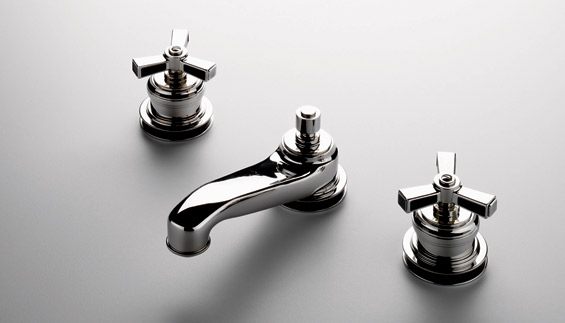
Above: Waterworks, Aero mounted lavatory faucet with cross handles
Released in April, O’Brien’s debut book, written along with Lisa Light, is a narrative and visual journey through O’Brien’s career. It is broken into seven chapters, each detailing a project in depth, and is generously illustrated with photographs by O’Brien’s Cooper Union classmate Laura Resen (A’87).O’Brien says he was careful not to write a how-to book, but American Modern is replete with information. Every item has a history, a reason for being implemented, and O’Brien shares these stories throughout.
For a client with a 1920s Dutch Colonial house in Connecticut with portions that date to 1834, O’Brien worked within a traditional vocabulary, sourcing many of the antiques from around New England. A 19th-century Sultanabad carpet was chosen for the living room, a collection of antique picture frames were fitted with handmade antique mirrors, and silver sconces and a Swedish table date from the 1920s. Aesthetic Movement William Morris wallpaper adorns the powder room, while in the dining room, two sets of chairs—one from the 1720s and one designed in the 1980s—stand on a hand-woven cotton chintz Belgian carpet.
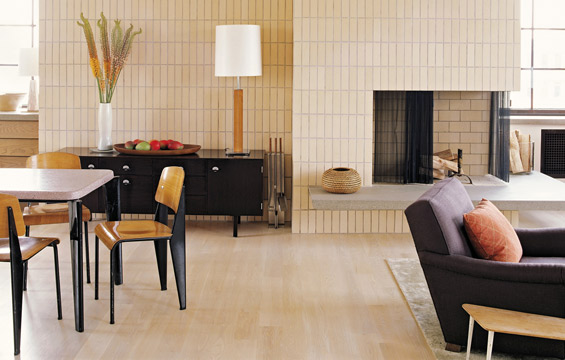
Above: Interior by Thomas O’Brien, photographs by Laura Resen; "American Modern"
In his own apartment on Manhattan’s Upper East Side, O’Brien initially opted for a sleek, spare “urban modern” aesthetic expressed in the rigid geometry of furnishings and a pale palette of white, grey and cream colors.Years later, he redecorated, adopting a “vintage modern” style in which his growing art collection took over the previously bare walls. Works by Imogen Cunningham, Edward Weston, Hiroshi Sugimoto and Max Weber hang in the bedroom. In the living room, a case holds a Greek bronze helmet, a GioPonti pitcher and a 19th-century Danmask, while a nearly Tang dynasty ceramic horse stands under a contemporary Laura Resen photograph.
In some cases, a client’s existing collection will provide the framework for an interior design. In a loft in the West Village, O’Brien mixed the client’s large collection of Jean Prouvé furniture with a variety of American Modernist pieces. An Isamu Noguchi paper lantern hangs about a Prouvé oak and metal dining table, which is paired with a set of vintage 1950s fiberglass Eames chairs.A1950s Jens Rison credenza that was refinished by Aero fits in a niche next to the fireplace; a tray from Aero—O’Brien’s take on traditional English butler’s trays—holds a silver bowl by Zaha Hadid.
 The product design arm of Aero had been producing designs for leading furnishing manufacturers for over a decade. Since 1999, O’Brien has been creating furniture for Hickory Chair; lines include the modern Thomas O’Brien collection, the Neoclassical and early-Modernist influenced Bellport Collection, and a recent antique inspired library collection, which includes sofas, chairs, bookcases, sideboards and tables. Bathroom fittings and hardware for Waterworks include the Aero, Aero Retro and Industrial Luxe collections.He’s produced several fabric lines for Groundworks; his tabletop collection for Reed&Barton includes flatware, dinnerware, crystal and decorative accessories. Hand-knotted carpets for Safavieh are created in hand spun Tibetan wool and silk.
The product design arm of Aero had been producing designs for leading furnishing manufacturers for over a decade. Since 1999, O’Brien has been creating furniture for Hickory Chair; lines include the modern Thomas O’Brien collection, the Neoclassical and early-Modernist influenced Bellport Collection, and a recent antique inspired library collection, which includes sofas, chairs, bookcases, sideboards and tables. Bathroom fittings and hardware for Waterworks include the Aero, Aero Retro and Industrial Luxe collections.He’s produced several fabric lines for Groundworks; his tabletop collection for Reed&Barton includes flatware, dinnerware, crystal and decorative accessories. Hand-knotted carpets for Safavieh are created in hand spun Tibetan wool and silk.
Vintage modern lighting for Visual Comfort—chandeliers, pendants, sconces and table and floor lamps—are introduced twice a year. Last year, O’Brien introduced a collection of crystal chandeliers.New collections from Hickory Chair and Visual Comfort are out this summer.
But it was the Vintage Modern collection for Target that made O’Brien a household name. When it debuted in 2005, it was one of the biggest launches the company had ever done, with some 500 pieces. It also made the Thomas O’Brien brand accessible at a large scale. Products include bedding, towels, carpets, dishes, lighting, furniture, stationery and holiday decor.
“Target has been great,” he says, noting that when he first went into Target’s corporate offices, it reminded him of going to IBM as a child. “They have given me an enormous amount of support—I have a product design machine now, and I’m really excited by the process. They asked me to create a softer modern palette. It’s knowable but it’s new—I feel as if it’s intended to remind you of something."
"They were recently here to talk about some things, and I got a nice little present. There’s a new A-to-Z Target commercial, and I’m the T.”
The success of the Vintage Modern collection at Target is a reflection of O’Brien’s appreciation of history, his creative instinct, and his ability to adapt his product designs to a wide range of markets. By eschewing design orthodoxy and remaining open to the entire spectrum of influences, O’Brien has, in a sense, risen above changing fashions. His appeal, like his approach, is timeless. “Design can be many things to many people, but to me, it has always been about tradition in modern life,” he writes in American Modern. “I am guided by traditions, both inherited and studied, which I will bend to the moment I’m living in.”

